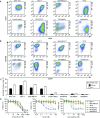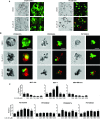Development of a screen to identify selective small molecules active against patient-derived metastatic and chemoresistant breast cancer cells
- PMID: 23879992
- PMCID: PMC4028696
- DOI: 10.1186/bcr3452
Development of a screen to identify selective small molecules active against patient-derived metastatic and chemoresistant breast cancer cells
Abstract
Introduction: High failure rates of new investigational drugs have impaired the development of breast cancer therapies. One challenge is that excellent activity in preclinical models, such as established cancer cell lines, does not always translate into improved clinical outcomes for patients. New preclinical models, which better replicate clinically-relevant attributes of cancer, such as chemoresistance, metastasis and cellular heterogeneity, may identify novel anti-cancer mechanisms and increase the success of drug development.
Methods: Metastatic breast cancer cells were obtained from pleural effusions of consented patients whose disease had progressed. Normal primary human breast cells were collected from a reduction mammoplasty and immortalized with human telomerase. The patient-derived cells were characterized to determine their cellular heterogeneity and proliferation rate by flow cytometry, while dose response curves were performed for chemotherapies to assess resistance. A screen was developed to measure the differential activity of small molecules on the growth and survival of patient-derived normal breast and metastatic, chemoresistant tumor cells to identify selective anti-cancer compounds. Several hits were identified and validated in dose response assays. One compound, C-6, was further characterized for its effect on cell cycle and cell death in cancer cells.
Results: Patient-derived cells were found to be more heterogeneous, with reduced proliferation rates and enhanced resistance to chemotherapy compared to established cell lines. A screen was subsequently developed that utilized both tumor and normal patient-derived cells. Several compounds were identified, which selectively targeted tumor cells, but not normal cells. Compound C-6 was found to inhibit proliferation and induce cell death in tumor cells via a caspase-independent mechanism.
Conclusions: Short-term culture of patient-derived cells retained more clinically relevant features of breast cancer compared to established cell lines. The low proliferation rate and chemoresistance make patient-derived cells an excellent tool in preclinical drug development.
Figures




References
Publication types
MeSH terms
Substances
Grants and funding
LinkOut - more resources
Full Text Sources
Other Literature Sources
Medical

